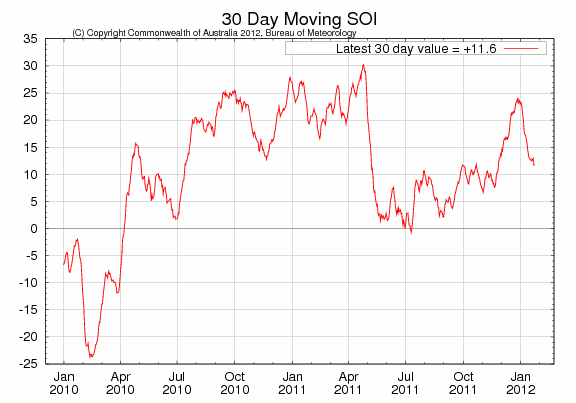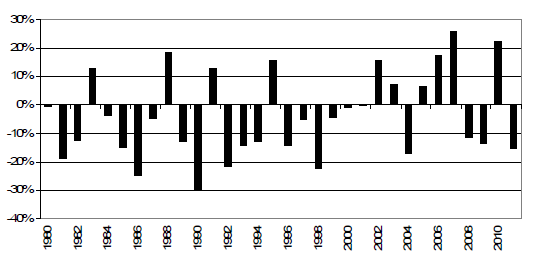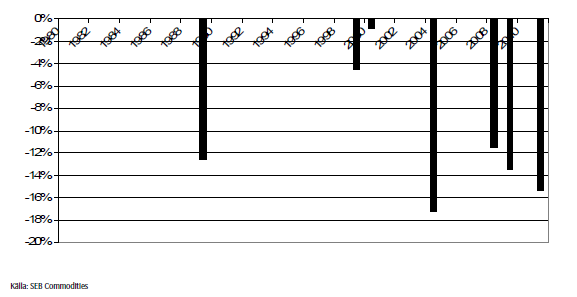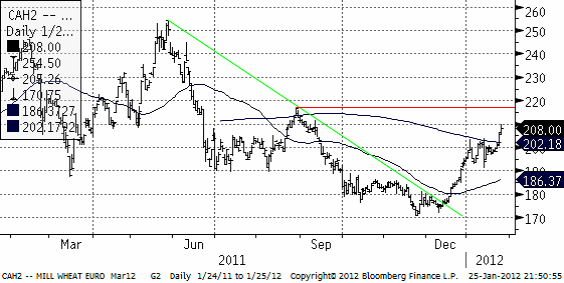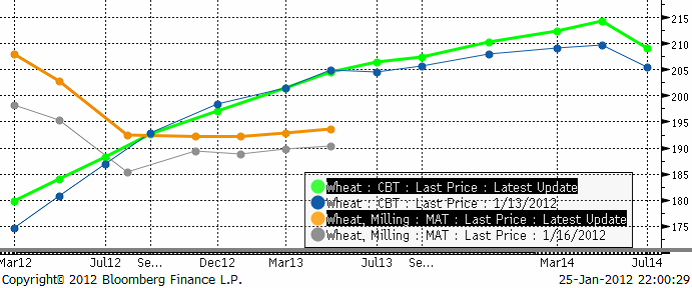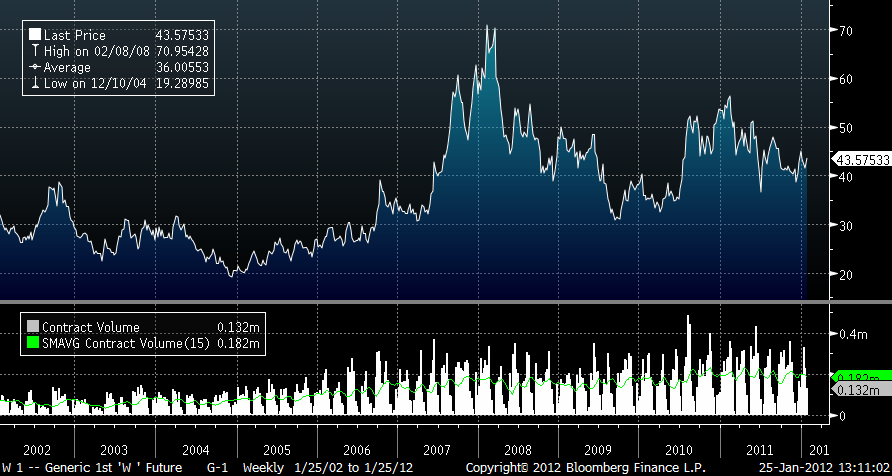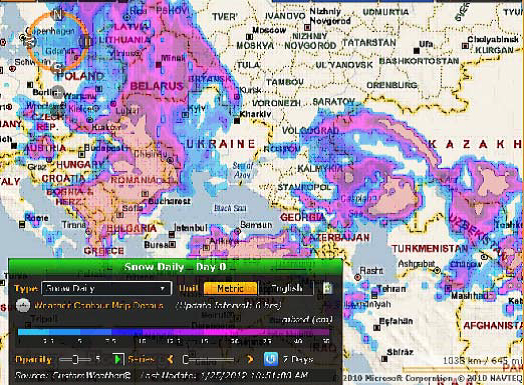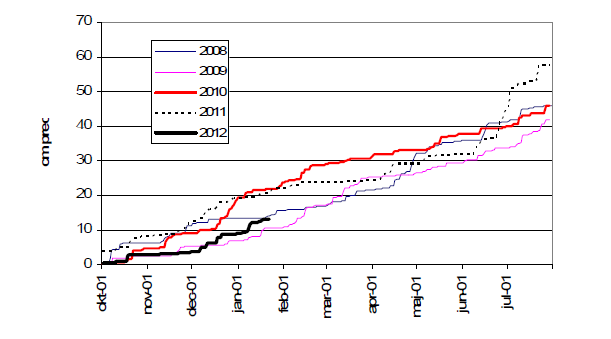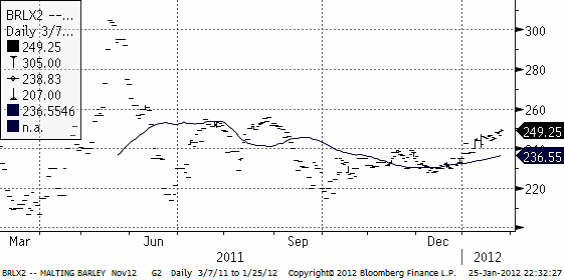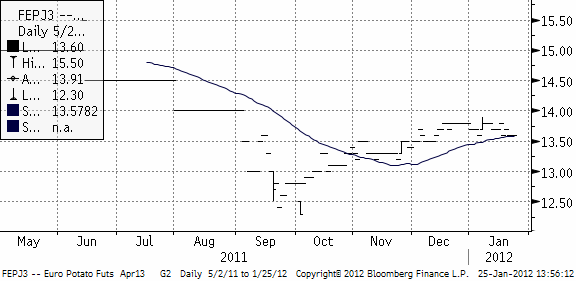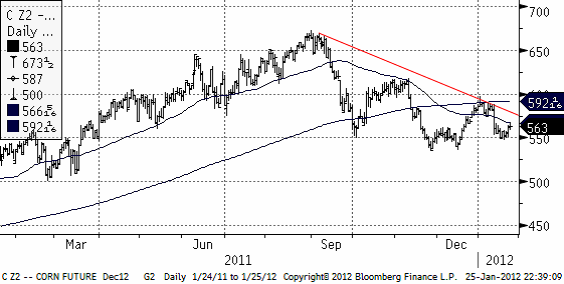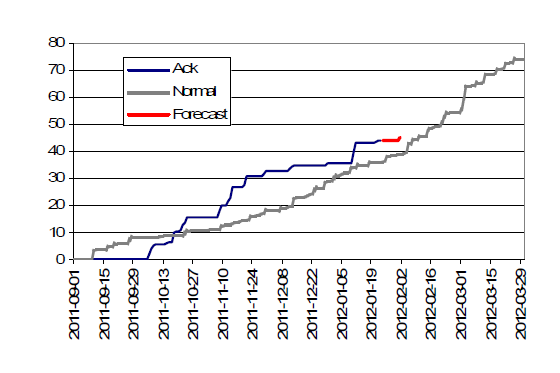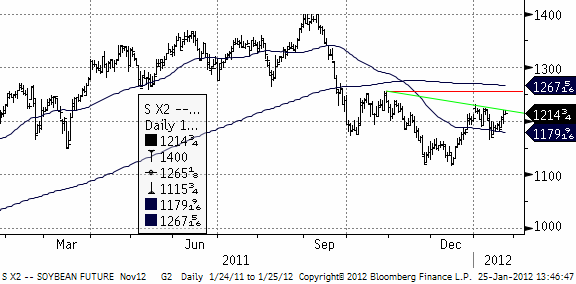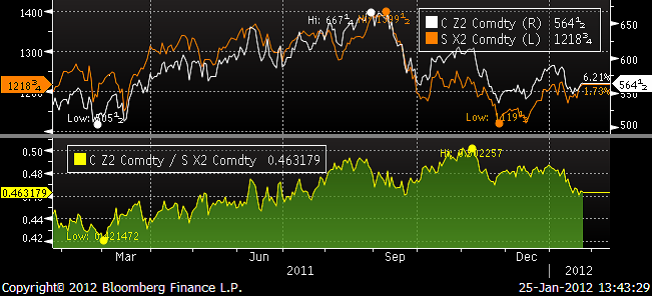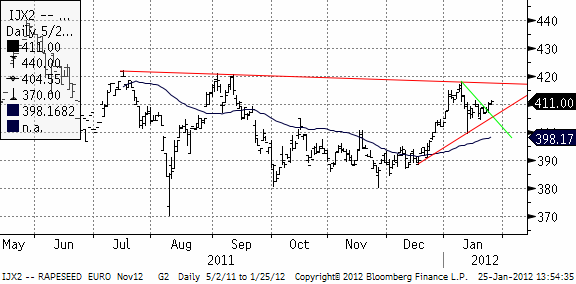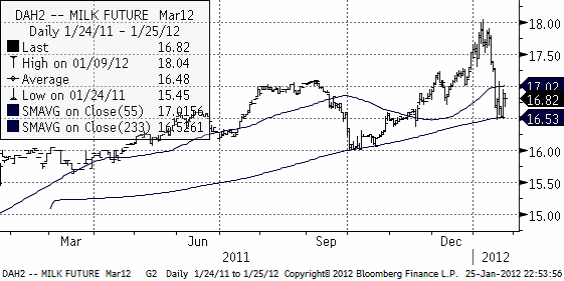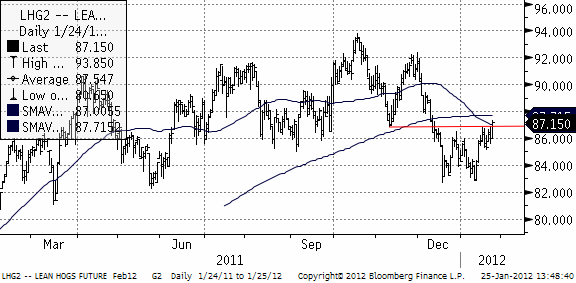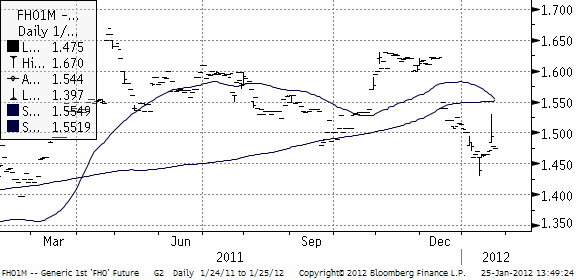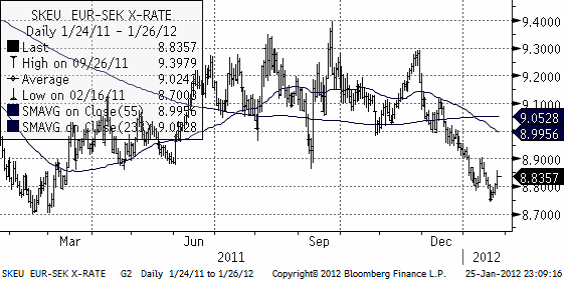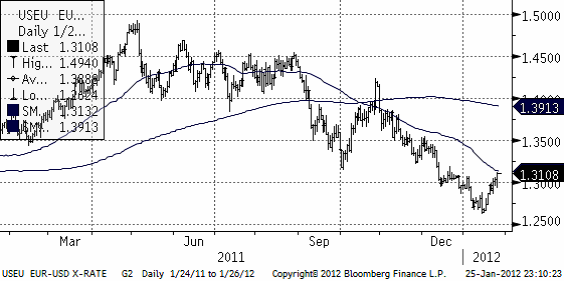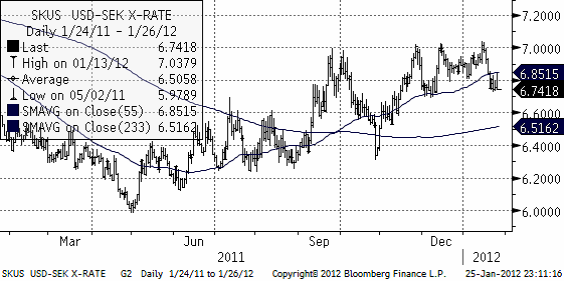Analys
SEB – Jordbruksprodukter, vecka 4
 Den senaste veckan har priserna på jordbruksprodukter stigit kraftigt, med Chicagovete i täten på +8%. Marknaden har haft lätt att trycka på köpknappen och tagit fasta på rykten om förestående exportstopp från Ryssland och från Argentina. Trots blixtsnabb officiell dementi från Argentinas jordbruksdepartement, vände inte marknaden ner. Det förefaller som om det är sentimentet som styr, snarare än fundamenta och då kan det också ganska snabbt vända ner igen.
Den senaste veckan har priserna på jordbruksprodukter stigit kraftigt, med Chicagovete i täten på +8%. Marknaden har haft lätt att trycka på köpknappen och tagit fasta på rykten om förestående exportstopp från Ryssland och från Argentina. Trots blixtsnabb officiell dementi från Argentinas jordbruksdepartement, vände inte marknaden ner. Det förefaller som om det är sentimentet som styr, snarare än fundamenta och då kan det också ganska snabbt vända ner igen.
Osäkerheten om torkan i Argentina och dess effekt på skörden är fortfarande ett orosmoment, liksom hur länge La Niña-förhållandena kommer att hålla i sig. Det finns också viss väderbaserad oro i botten för ryktet att Ryssland skulle ställa in exporten.
Positiva nyheter, främst att det regnat i början av veckan över hela norra Argentina har marknaden tagit ganska lätt på. El Rural skriver att det är för sent att så majs, men att bönder sår sen soja i den fuktiga marken.
Börsen ICE Futures Canada, den Winnipeg-baserade jordbruksbörsen som ägs av Intercontinental Exchange, lanserade i måndags futureskontrakt och optioner på kvarnvete, durumvete och korn med leveranspunkter i Kanada. Merparten av vete och korn produceras i Kanadas västra provinser, såsom Manitoba, Saskatchewan, Alberta och British Columbia och sedan 1943 har the Canadian Wheat Board (CWB) haft ett legalt monopol på all köp och försäljning av dessa jordbruksprodukter.
Bill C-18, som infördes av den konservativ/liberala regeringen i Kanada i slutet av oktober förra året kommer att avsluta CWB:s monopolställning och tillåta vete, durumvete och korn från västra Kanada att handlas fritt för första gången på nästan 70 år. Den nya lagen kommer inte att avskaffa CWB, men den kommer att fråntas sin position som den enda köparen av vete från kanadensiska lantbrukare.
Slutligen, värt att tänka på är IMF:s prognos för råvarumarknadens utveckling under 2012 som släpptes i tisdags. Man förutspår att råvarupriserna (utom olja) kommer att falla med i genomsnitt 14%, med de största prisfallen på jordbruksprodukter.
La Niña
Det råder väl inget tvivel om att det är La Niña-fenomenet som står i centrum för skörden i Argentina och södra Brasilien. Fenomenet påverkar också vädret i Nordamerika. Det är därför det är extra torrt där också. Som vi har berättat tidigare har fenomenet nått sin kritiska nivå vid årsskiftet och har fortsatt att försvagas de senaste två veckorna. I diagrammet nedan ser vi utvecklingen av Southern Oscillation Index (”SOI”) på daglig basis. Ett värde >8 innebär att det råder La Niña.
Det finns en rad modeller för att göra prognoser på framtida ENSO-förhållanden. Nedan ser vi en ”plym” av sådana prognoser framåt i tiden. Vi ser att La Niña väntas hålla i sig fram till hösten. Då ska vi kanske också notera att tillförlitligheten på ENSO-prognoser sträcker sig ungefär 6 månader framåt i tiden. Det finns alltså risker för La Niña-orsakad torka under sommaren.
Hur påverkar ett övergående La Niña vetepriset?
Vi har gjort en studie av hur vetepriset (Chicago) förändras mellan den sista december och den sista juli varje år. Vi ser en bild på dessa prisförändringar i procent nedan.
Genomsnittet är en prisnedgång på 4% (en mycket stor anledning att sälja terminer på vintern, för övrigt). Om vi sedan väljer ut de ”vårar” när det varit La Niña-förhållanden vid årsskiftet, hur har det gått då? Det visar sig att man då får enbart får fram vårar med prisnedgångar, som vi ser i diagrammet nedan.
Den genomsnittliga prisnedgången på dessa 7 år sedan 1980 till och med 2011 är 11%. Just vid årsskiftet hade vi ett Southern Oscillation Index på nästan 25 och ett värde > 8 indikerar ett aktivt La Niña-fenomen. Vi vet dessutom att detta enligt prognosen kommer att klinga av under våren. Det är med andra ord upplagt för prisfall i vete. Vetepriset står på ungefär samma nivå nu som det gjorde vid årsskiftet. Man kan säkerligen finna motsvarande prognos om prisfall för sojabönor och majs för samma år (i år).
Vete
Chicagovetet har stigit med 8% på en vecka för gammal skörd, men bara 4% för ny skörd. Ny skörd på Matif steg med bara 2%. Chicagovetet är den jordbruksråvara som har stigit mest alla den senaste veckan.
Bakom uppgången låg rykten – dels om att Argentina skulle införa exportstopp på soja och majs, dels på att Ryssland ska införa exportstopp på vete igen per den 1 mars. Argentinas jordbruksdepartement dementerade snabbt, men inget hördes från Ryssland. Nyhetsbyråer rapporterar att Kazakstan är ute och försöker köpa 8 mt till de statliga reservlagren.
Den tidigare uppgiften var att de tänkte köpa 5mt. Misstanken uppstår då att de vet att exporten inte kommer att bli så stor. Mellan september och december exporterades 4.1 mt. Samtidigt kom privata firmors estimat på majsskörden i Argentina, som ligger långt under USDAs estimat från januari-WASDE. Dock finns det mycket vete i världen och mer verkar det som för varje månad som går. En snabb blick i förra veckans rapporter verkar konstatera samma sak.
Enligt IGC (International Grains Council) har uppskattningen av den globala veteproduktionen under 2011 justerats upp med 7 miljoner ton, jämfört med november-rapporten, till rekordhöga 690 miljoner ton. Ökningen avspeglar bättre än förväntade skördar på det södra halvklotet, speciellt i Argentina och Australien, men också betydande ökningar i Kina och Kazakstan. Ungefär hälften av den justeringen beror på ökad användning i foder, då konkurrenskraftiga priser (jämfört med majs) har lett till högre efterfrågan.
Globala utgående lager i slutet av 2011/12 revideras också upp och förväntas nu uppgå till 204 miljoner ton, vilket är strax under rekordet på 206 miljoner ton 1999/00. Lagren förväntas öka kraftigt i de stora exportländerna Kazakstan och Ukraina, medan de i EU och USA förväntas vara oförändrade. En stor del av ökningen tillskrivs också Kina och blir därför i stort sett oåtkomliga för den globala marknaden.
Den globala arealen för veteproduktion 2012 förväntas öka 1.7% till 225 miljoner hektar, den största sedan 1998. Huvuddelen av denna ökning förväntas bli i USA och OSS, till följd av attraktiva inhemska och internationella priser, där prognosen baseras på normala väderförhållanden. Bortsett från torka i delar av USA och Ukraina rapporteras det om att utsikterna för höstvetet på norra halvklotet anses vara god.
Den franska analysfirman Strategie Grains uppskattar globala utgående lager till rekordhöga 211 miljoner i slutet av 2012/13, samma siffra som Ag Canada har i sin rapport. Enligt USDA är rekordsiffran för globala utgående lager 210.7 miljoner ton och sattes 1999/00 medan IGC har en något lägre uppskattning av den siffran med 206 miljoner ton. Strategie grains prognos baseras på ökade skördar i Kina, Ryssland, USA och Europa.
Veteskörden i Europa för 2012 förväntas uppgå till 133,3 miljoner ton och även om den har justerats ned med 200 000 ton från förra månadens estimat till följd av minskad sådd i Tyskland, regionens näst största producent efter Frankrike, så är det fortfarande en ökning med 3% jämfört med 2011/12. Räknar man dessutom in durumvetet blir det en förväntad skörd på 142.2 miljoner ton. Ryssland förväntar sig att 2012 års skörd kommer att bli lika bra som förra årets, om inte bättre. För Ukraina ser det sämre ut pga den svåra torkan i höstas som varade i 3 1/2 månad från september till december.
Nedan ser vi kursdiagrammet för marskontraktet på Matif, som verkligen brutit uppåt. Nästa motstånd ligger på 217 euro, men under gårdagen fanns det gott om säljare på 210 euro, som blev toppen på dagens handel.
Det är något märkligt att Matif går ännu mer in i backwardation genom att det är gammal skörd som handlas upp. Det talas om att det kooperativ som köper tillbaka gamla sålda terminer, samtidigt som bönder i Europa fortsätter och kanske i än större utsträckning håller på fysiska lager.
Ur ett teknisk analysperspektiv noterar vi att förra veckans uppgång (över 191.50-motståndet), men under motståndet på 217.50, har skapat förutsättningarna för vad som kallas för en ”bull trap”, där man lockas att köpa, men sedan vänder marknaden tvärt nedåt. Tekniska momentumindikatorer rör sig i motsatt riktning just nu, och det talar för att en vändning nedåt kan komma i priset.
Nedan ser vi terminskurvan för Chicagovete och Matif nu och för en vecka sedan. De ”feta” kurvorna är de aktuella. De ”smala” är förra veckans.
Matif har som vi berört gått ännu mer in i backwardation pga gammal skörd handlats upp.
Nedan ser vi vetepriset på CBOT omräknat till svenska kronor per bushel (27 kilo) de senaste tio åren. I den nedre delen ser vi omsättningen i antal kontrakt.
Det ryktades under tisdagen om ryskt exportstopp från 1 mars, vilket skulle kunna ligga bakom prisuppgången på gammal skörd.
I sin WASDE-rapport i januari estimerade USDA rysk veteexport till 19.5 mt för marknadsföringsåret juli 2011 till juni 2012. Det var en liten höjning från decemberprognosen som låg på 19 mt. Det förefaller helt klart att man sålt slut på allt vete i de södra delarna av landet och att man nu kämpar med logistiken för att få ut det som finns längre in i landet. Putin har satt exportgränsen till 25 mt, så än finns en stor marginal till det taket.
Frågan är varför ett exportstopp ändå skulle införas?
Det har snöat kraftigt i delar av Ryssland, men det finns motstridiga uppgifter om huruvida snön fallit på jordbruksmark eller inte. Det förefaller som om det gjort det, till viss, men ganska liten del. Nedan ser vi en radarbild på snöfall över södra Ryssland och att snön missat viktiga regioner som Voronetz och Tambov.
Nedan ser vi ackumulerad nederbörd i staden Kursk, som ligger nära jordbruksområdena. Vi ser att det mycket riktigt varit torrt under hösten och att det kan finnas en viss oro. Den röda grafen var den som ledde fram till torkan och missväxten under sommaren 2010 och det året började med mycket nederbörd, så än går inte att säga hur året kommer att bli.
Samtidigt som det finns oro för Ryssland, ser det mycket positivt ut i Australien. Australian Bureau of Statistics rapporterade igår onsdag att lagren i Australien är de största sedan år 2006. Förra året uppgick lagren (per årsskiftet) till 18.2 mt. I år var lagren 24.6 mt, efter att australiensiska bönder bärgat den andra rekordskörden på raken. Skörden väntas uppgå till 28.3 mt 2011-2012 och slår därmed förra årets rekord på 27.9 mt enligt Australian Bureau of Agricultural and Resource Economics and Sciences. Australien är världens näst största exportland efter USA. Enligt ABARES kan exporten nå 21.6 mt.
En delförklaring till de strora lagren är att carryover per den 30 september var 8.3 mt. I år väntas den bli ännu något större.
Om man nu ska sammanfatta läget, så anser vi att sentimentet just nu helt klart verkar vara ganska ”triggerhappy” på köpknappen. Man tar fasta på rykten. Det verkar finnas en stor oro för vädret, sannolikt med 2007 och 2010 i färskt minne. Samtidigt, eftersom det inte handlar om fakta, kan vändningen bli lika tvär nedåt igen. Den kraftiga backwardation som finns på Matif – som signalerar brist på fysisk vara – samtidigt som det knappast finns en fysisk brist i Europa (extremt få GASCtenders vunna och mycket spannmål kvar hos bönderna), är gammal skörd solklart säljvärd. Tror man på högre priser – köp terminerna med längre löptid billigare i så fall.
Vi fortsätter att tro på en nedgång i vetepriset under året och tycker att man i första hand ska sälja av gammal skörd på den uppgång vi nu sett.
Maltkorn
Maltkornet har fortsatt att handlas upp och priset för novemberleverans tangerar nu 250 euro per ton. Motstånd finns strax ovanför, på ca 255 euro.
Argentinska La Nacion rapporterar om landet har fått den högsta maltkornsskörden på 10 år. Skörden uppgår till 3.65 miljoner ton och arealen för maltkornsproduktion har ökat med nästan 50% jämfört med 2010/11. En av de viktigaste orsakerna till denna ökning är att producenterna försöker hitta ett alternativ till vete och en tidig maltkornsskörd ger också möjligheten att så sojabönor efteråt.
Även fast skörden sedan länge är avklarad i Europa verkar det fortfarande råda en viss osäkerhet om tillgången på maltkorn då väderförhållandena under 2011 har lett till betydande kvalitetsproblem.
Den skandinaviska skörden drabbades bl a av höga koncentrationer av fusarium vilket ger kvalitetsstörningar i mältnings- och bryggningsprocessen genom skumbildning, så kallad ”gushing”, och andra länder, t.ex Frankrike, har haft stora problem med proteinhalter. För hög proteinhalt ger grumligt öl.
Potatis
Priset på potatis har fortsatt att försvagas och när nu nära att bryta 55-dagars glidande medelvärde, vilket vore en negativ teknisk signal.
Majs
Ur ett teknisk analysperspektiv noterar vi att majspriset är uppe vid 55-dagars glidande medelvärde, som utgör ett slags motstånd (många tittar på just den indikatorn). Nedan ser vi decemberkontraktet på CBOT:
Det gick ett rykte under tisdagen den 24 januari att Argentina skulle införa ett exportstopp på majs, men detta dementerades snabbt av jordbruksministeriet, men prisuppgången stannade ändå kvar. FAO estimerar skörden av majs i Argentina till 21.4 mt, där USDA senast estimerade 26 mt. Privata firmor ligger ännu lägre, på 17-18 mt. Orsaken är som bekant, torkan som varit och som permanent skadat majsskörden. Sojan verkar kunna repa sig, men alltså inte majsen.
Nedan ser vi ackumulerad nederbörd i Cordoba, Argentina. Den blåa grafen visar ackumulerad nederbörd sedan september förra året. Den lilla röda snutten är den senaste väderleksprognosen, som har ungefär 12 mm nederbörd för den 30 januari till den 1 februari. Vi ser att nederbörden som föll i början av den här veckan var en ganska kraftig sådan, betydligt mer än vad som var förutspått.
Det är alltså trots den nederbörd som kom i början på veckan, ändå något lite för lite nederbörd så här års mot vad det borde vara ett normalår. Detta är ett orosmoment, främst för sojan eftersom tärningen redan är mer eller mindre kastad för majsen.
Sojabönor
Priset på novemberkontraktet SX2 ligger precis under ett motstånd på 1215 cent. Det finns flera motstånd strax ovanför, men formationen liknar en omvänd head-and-shoulders, vilket alltså har en potentiellt ”bullish” innebörd. Det finns utrymme upp till 1245 och en uppgång över den nivån skulle ge ytterligare skjuts uppåt.
Vi ser i nedanstående diagram som visar kvoten mellan majs- och sojapris att majsen tappat i pris i förhållande till sojabönor, men det finns ingen direkt brist av sojabönor i världen.
Om regnen kommer till Argentina som väntat vid månadsskiftet bör hektarskörden kunna stabiliseras. Det är snarare majsmarknaden som är svag än sojamarknaden som är stark. Det finns gott om tekniska motstånd på ovansidan och det är knappast troligt att en ny bullmarknad skulle orka ta sig rakt igenom dem.
Raps
Tekniskt har novemberkontraktet just brutit ett kortsiktigt motstånd och torde röra sig uppåt de närmaste dagarna för att testa motståndet på 420 euro. En uppgång över 420 euro vore en mycket stark köpsignal, annars skulle en uppgång mot 420 euro också kunna vara ett bra tillfälle att sälja om priset inte bryter igenom.
Höstens torra väder i Ukraina kommer också att påverka årets rapsskörd och man räknar med att produktionen kommer att falla 19% till 1.13 miljoner ton vilket skulle vara den lägsta på 5 år enligt data från USDA. EU´s importbehov av raps förväntas bli mycket hög. Den globala produktionen av raps och canola uppskattas uppgå till totalt 61.5 miljoner ton 2012/13, en ökning med 3.4% och den första ökningen på 3 år. Utifrån väderproblemen i Ukraina, en betydligt mindre sådd av höstraps i EU och sjunkande lager, så kommer det att krävas ytterligare ökning av den kanadensiska canola produktionen för att möta efterfrågan under 2012.
Enligt Ag Canada kommer ytterligare areal att tas i bruk för canola produktion och förväntas nå rekordhöga 8.0 miljoner hektar, vilket skulle vara tillräckligt för att få en all-time high skörd på 15 miljoner ton.
Mjölk
Nedan ser vi priset på marskontraktet på flytande mjölk (kontakt avräknat mot USDA:s prisindex). Rekylen från toppnoteringen vid 18 dollar studsade på 16.50 och de senaste dagarna har priset pendlat mellan 16.50 och 17 med förhållandevis stora
Gris
Priset på lean hogs är uppe i sälj-zonen igen. Med så många typer av tekniska motstånd ansamlade vid och strax ovanför där priset ligger idag, är sannolikheten låg att priset tar sig rakt igenom. Vi rekommenderar att man säljer vid den här nivån. Statistik från Kina visar att grispopulationen sjönk i december för första gången på 10 månader. Samtidigt rapporteras som utbrott av African Swine Fever (ASF) på flera håll i världen, bland annat i olika regioner samtidigt i Ryssland.
Vi intar ändå, baserat på den tekniska analysen, en negativ hållning och rekommendationen blir:
1 vecka: negativ
3 månader: negativ
Nedan ser vi februarikontraktet
Priset i Europa har betett sig på samma sätt. Nedan ser vi det vid var tid kortaste terminskontraktet (närmast spot):
Valutor
EURSEK – försöker korrigera nedgången
Vi har en neutral rekommendation på både en veckas sikt och tre månaders.
EURUSD – i rekyl fortfarande
Kursen har rekylerat upp till 55-dagars glidande medelvärde, som borde utgöra ett visst motstånd.
Rekommendation: Neutral på en veckas sikt. Negativ på tre månader.
USDSEK – söker efter en botten i korrektionen nedåt
Dollarn föll inte mycket mot kronan efter FOMC-mötet på onsdagskvällen, trots att räntan kommer att ligga kvar på ultralåg nivå till åtminstone 2014, enligt Ben B. Ändå ligger kursen under 55-dagars glidande medelvärde och ny ordentlig uppgång och test av 7-kronors-nivån kan vi inte vänta så länge kursen ligger under medelvärdet.
Vi har en neutral rekommendation på en veckas sikt, men är positive på tre månader.
[box]SEB Veckobrev Jordbruksprodukter är producerat av SEB Merchant Banking och publiceras i samarbete och med tillstånd på Råvarumarknaden.se[/box]
Disclaimer
The information in this document has been compiled by SEB Merchant Banking, a division within Skandinaviska Enskilda Banken AB (publ) (“SEB”).
Opinions contained in this report represent the bank’s present opinion only and are subject to change without notice. All information contained in this report has been compiled in good faith from sources believed to be reliable. However, no representation or warranty, expressed or implied, is made with respect to the completeness or accuracy of its contents and the information is not to be relied upon as authoritative. Anyone considering taking actions based upon the content of this document is urged to base his or her investment decisions upon such investigations as he or she deems necessary. This document is being provided as information only, and no specific actions are being solicited as a result of it; to the extent permitted by law, no liability whatsoever is accepted for any direct or consequential loss arising from use of this document or its contents.
About SEB
SEB is a public company incorporated in Stockholm, Sweden, with limited liability. It is a participant at major Nordic and other European Regulated Markets and Multilateral Trading Facilities (as well as some non-European equivalent markets) for trading in financial instruments, such as markets operated by NASDAQ OMX, NYSE Euronext, London Stock Exchange, Deutsche Börse, Swiss Exchanges, Turquoise and Chi-X. SEB is authorized and regulated by Finansinspektionen in Sweden; it is authorized and subject to limited regulation by the Financial Services Authority for the conduct of designated investment business in the UK, and is subject to the provisions of relevant regulators in all other jurisdictions where SEB conducts operations. SEB Merchant Banking. All rights reserved.
Analys
Tightening fundamentals – bullish inventories from DOE

The latest weekly report from the US DOE showed a substantial drawdown across key petroleum categories, adding more upside potential to the fundamental picture.

Commercial crude inventories (excl. SPR) fell by 5.8 million barrels, bringing total inventories down to 415.1 million barrels. Now sitting 11% below the five-year seasonal norm and placed in the lowest 2015-2022 range (see picture below).
Product inventories also tightened further last week. Gasoline inventories declined by 2.1 million barrels, with reductions seen in both finished gasoline and blending components. Current gasoline levels are about 3% below the five-year average for this time of year.
Among products, the most notable move came in diesel, where inventories dropped by almost 4.1 million barrels, deepening the deficit to around 20% below seasonal norms – continuing to underscore the persistent supply tightness in diesel markets.
The only area of inventory growth was in propane/propylene, which posted a significant 5.1-million-barrel build and now stands 9% above the five-year average.
Total commercial petroleum inventories (crude plus refined products) declined by 4.2 million barrels on the week, reinforcing the overall tightening of US crude and products.


Analys
Bombs to ”ceasefire” in hours – Brent below $70

A classic case of “buy the rumor, sell the news” played out in oil markets, as Brent crude has dropped sharply – down nearly USD 10 per barrel since yesterday evening – following Iran’s retaliatory strike on a U.S. air base in Qatar. The immediate reaction was: “That was it?” The strike followed a carefully calibrated, non-escalatory playbook, avoiding direct threats to energy infrastructure or disruption of shipping through the Strait of Hormuz – thus calming worst-case fears.

After Monday morning’s sharp spike to USD 81.4 per barrel, triggered by the U.S. bombing of Iranian nuclear facilities, oil prices drifted sideways in anticipation of a potential Iranian response. That response came with advance warning and caused limited physical damage. Early this morning, both the U.S. President and Iranian state media announced a ceasefire, effectively placing a lid on the immediate conflict risk – at least for now.
As a result, Brent crude has now fallen by a total of USD 12 from Monday’s peak, currently trading around USD 69 per barrel.
Looking beyond geopolitics, the market will now shift its focus to the upcoming OPEC+ meeting in early July. Saudi Arabia’s decision to increase output earlier this year – despite falling prices – has drawn renewed attention considering recent developments. Some suggest this was a response to U.S. pressure to offset potential Iranian supply losses.
However, consensus is that the move was driven more by internal OPEC+ dynamics. After years of curbing production to support prices, Riyadh had grown frustrated with quota-busting by several members (notably Kazakhstan). With Saudi Arabia cutting up to 2 million barrels per day – roughly 2% of global supply – returns were diminishing, and the risk of losing market share was rising. The production increase is widely seen as an effort to reassert leadership and restore discipline within the group.
That said, the FT recently stated that, the Saudis remain wary of past missteps. In 2018, Riyadh ramped up output at Trump’s request ahead of Iran sanctions, only to see prices collapse when the U.S. granted broad waivers – triggering oversupply. Officials have reportedly made it clear they don’t intend to repeat that mistake.
The recent visit by President Trump to Saudi Arabia, which included agreements on AI, defense, and nuclear cooperation, suggests a broader strategic alignment. This has fueled speculation about a quiet “pump-for-politics” deal behind recent production moves.
Looking ahead, oil prices have now retraced the entire rally sparked by the June 13 Israel–Iran escalation. This retreat provides more political and policy space for both the U.S. and Saudi Arabia. Specifically, it makes it easier for Riyadh to scale back its three recent production hikes of 411,000 barrels each, potentially returning to more moderate increases of 137,000 barrels for August and September.
In short: with no major loss of Iranian supply to the market, OPEC+ – led by Saudi Arabia – no longer needs to compensate for a disruption that hasn’t materialized, especially not to please the U.S. at the cost of its own market strategy. As the Saudis themselves have signaled, they are unlikely to repeat previous mistakes.
Conclusion: With Brent now in the high USD 60s, buying oil looks fundamentally justified. The geopolitical premium has deflated, but tensions between Israel and Iran remain unresolved – and the risk of missteps and renewed escalation still lingers. In fact, even this morning, reports have emerged of renewed missile fire despite the declared “truce.” The path forward may be calmer – but it is far from stable.
Analys
A muted price reaction. Market looks relaxed, but it is still on edge waiting for what Iran will do

Brent crossed the 80-line this morning but quickly fell back assigning limited probability for Iran choosing to close the Strait of Hormuz. Brent traded in a range of USD 70.56 – 79.04/b last week as the market fluctuated between ”Iran wants a deal” and ”US is about to attack Iran”. At the end of the week though, Donald Trump managed to convince markets (and probably also Iran) that he would make a decision within two weeks. I.e. no imminent attack. Previously when when he has talked about ”making a decision within two weeks” he has often ended up doing nothing in the end. The oil market relaxed as a result and the week ended at USD 77.01/b which is just USD 6/b above the year to date average of USD 71/b.

Brent jumped to USD 81.4/b this morning, the highest since mid-January, but then quickly fell back to a current price of USD 78.2/b which is only up 1.5% versus the close on Friday. As such the market is pricing a fairly low probability that Iran will actually close the Strait of Hormuz. Probably because it will hurt Iranian oil exports as well as the global oil market.
It was however all smoke and mirrors. Deception. The US attacked Iran on Saturday. The attack involved 125 warplanes, submarines and surface warships and 14 bunker buster bombs were dropped on Iranian nuclear sites including Fordow, Natanz and Isfahan. In response the Iranian Parliament voted in support of closing the Strait of Hormuz where some 17 mb of crude and products is transported to the global market every day plus significant volumes of LNG. This is however merely an advise to the Supreme leader Ayatollah Ali Khamenei and the Supreme National Security Council which sits with the final and actual decision.
No supply of oil is lost yet. It is about the risk of Iran closing the Strait of Hormuz or not. So far not a single drop of oil supply has been lost to the global market. The price at the moment is all about the assessed risk of loss of supply. Will Iran choose to choke of the Strait of Hormuz or not? That is the big question. It would be painful for US consumers, for Donald Trump’s voter base, for the global economy but also for Iran and its population which relies on oil exports and income from selling oil out of that Strait as well. As such it is not a no-brainer choice for Iran to close the Strait for oil exports. And looking at the il price this morning it is clear that the oil market doesn’t assign a very high probability of it happening. It is however probably well within the capability of Iran to close the Strait off with rockets, mines, air-drones and possibly sea-drones. Just look at how Ukraine has been able to control and damage the Russian Black Sea fleet.
What to do about the highly enriched uranium which has gone missing? While the US and Israel can celebrate their destruction of Iranian nuclear facilities they are also scratching their heads over what to do with the lost Iranian nuclear material. Iran had 408 kg of highly enriched uranium (IAEA). Almost weapons grade. Enough for some 10 nuclear warheads. It seems to have been transported out of Fordow before the attack this weekend.
The market is still on edge. USD 80-something/b seems sensible while we wait. The oil market reaction to this weekend’s events is very muted so far. The market is still on edge awaiting what Iran will do. Because Iran will do something. But what and when? An oil price of 80-something seems like a sensible level until something do happen.
-

 Nyheter4 veckor sedan
Nyheter4 veckor sedanStor uppsida i Lappland Guldprospekterings aktie enligt analys
-

 Nyheter4 veckor sedan
Nyheter4 veckor sedanSilverpriset släpar efter guldets utveckling, har mer uppsida
-

 Nyheter3 veckor sedan
Nyheter3 veckor sedanUppgången i oljepriset planade ut under helgen
-

 Nyheter2 veckor sedan
Nyheter2 veckor sedanMahvie Minerals växlar spår – satsar fullt ut på guld
-

 Nyheter3 veckor sedan
Nyheter3 veckor sedanLåga elpriser i sommar – men mellersta Sverige får en ökning
-

 Analys3 veckor sedan
Analys3 veckor sedanVery relaxed at USD 75/b. Risk barometer will likely fluctuate to higher levels with Brent into the 80ies or higher coming 2-3 weeks
-

 Nyheter2 veckor sedan
Nyheter2 veckor sedanOljan, guldet och marknadens oroande tystnad
-

 Nyheter2 veckor sedan
Nyheter2 veckor sedanJonas Lindvall är tillbaka med ett nytt oljebolag, Perthro, som ska börsnoteras


